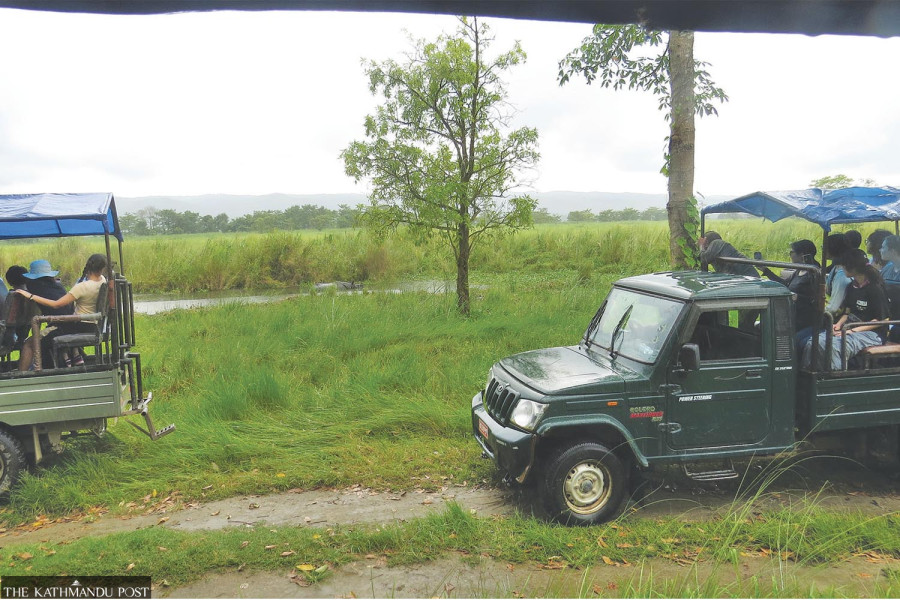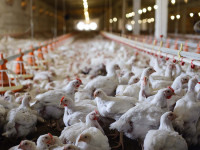Money
Sauraha thrives year-round, drawing visitors in both summer and monsoon
Jeep safaris in Chitwan National Park’s buffer zones are booming during the rainy season.
Ramesh Kumar Paudel
On a cloudy Saturday afternoon, a jeep arrived on the premises of the Kumroj buffer zone community forest office in the eastern part of Sauraha. After completing a few formalities, the jeep started boarding tourists, and soon it headed towards the jungle.
Jeep safaris are increasingly becoming popular during the monsoon season in the buffer zones of Chitwan National Park, the country’s first national park.
During this time of year, the forest turns lush green. Peacocks, the most colourful birds in the world, make various calls and sounds to attract mates and claim their territory. Hundreds of birds fly here and there along the banks of the Narayani and Rapti rivers.
Park officials say that the monsoon creates a special excitement for tourists.
Fifteen minutes into the safari, clouds started blanketing the skies of the national park and its surroundings, and it rained heavily. As the jeep's roof was unable to protect tourists from the rain, some tourists opened their umbrellas.
In the meantime, tourists came upon a small pond where two rhinos were playing.
The four jeeps stopped, and tourists started observing and taking photos.
The scene was so serene that you could hear a pin drop as the tourists watched the wild animals in action.
Despite the downpour, no one seemed bothered.
“It’s the monsoon season. Tourists are increasingly coming for jeep safaris in the buffer zone,” said Ganesh Shrestha, president of Kumroj buffer zone community forest. In the monsoon season, which begins in June and lasts until the end of September, the national park is closed for elephant and jeep safaris.
However, Shrestha said that the buffer zone jeep safaris have become a big draw.
“The jeep safari in the buffer zone never disappoints visitors.”
Almost all types of wild animals found in the park are also present in the buffer zone.
In Nepal, the peak tourist seasons are spring (March-May) and autumn (September-October), when the skies are clear and the weather is pleasant.
In the park, foreign and domestic movements start mainly after the end of the monsoon, or with the start of the Dashian and Tihar festivals. Nowadays, the national park is a place to visit during all seasons.
While elephant safaris have declined in popularity, jeep safaris are on the rise.
Kumroj buffer zone community forest operates up to 60 jeep safaris a day, starting early in the morning. Each jeep, which can accommodate 11 people, is almost always full.
“During the holidays, we run 50-60 jeep safaris daily. This is double the usual number during other seasons,” said Shrestha.
Kumroj buffer zone community forest, located on the bank of the Rapti River, south of Khairhani municipality, has densely populated trees, which were planted in 1983 to protect the local village from flooding.
What began as a flood prevention effort has since grown into a thriving forest, now home to tigers, rhinos, cheetahs, and deer. “It’s now one of the top spots for tourists,” Shrestha said.
Spread over 691 hectares, Kumroj forest was registered in 1986 as a ‘Panchayat Forest”, named after the political system in Nepal from 1961 to 1990. It was then registered as the Kumroj buffer zone community forest, and in 1994, the first elephant safari was started.
The community forest started earning well after it started offering jeep safaris in 2016.
The forest earned Rs45.6 million in the last fiscal year, with a significant share coming from jeep safaris.
Jeep safaris inside the Chitwan National Park are closed from July until the end of the monsoon, said Ganesh Prasad Tiwari, chief conservation officer at the Chitwan National Park. “Once the monsoon ends, jeep safaris resume after repairing the damaged roads and bridges.”
“During the monsoon, only walking is allowed inside the park so visitor numbers drop significantly,” Tiwari said. However, in the buffer zone’s community forests outside the park, activities like jeep safari, elephant rides, and boat tours continue with careful planning.
According to Tiwari, the spokesperson for the national park, jeep safaris are ongoing in other community forests including Kuchkuche, nearby Kumroj, Jagatpur, and Meghauli in the west, and Gundrehi Dakaha and Namuna buffer zone community forest in the Amaltari area of Nawalparasi.
Jitu Tamang, president of the Baghmara community forest, which is managed by local residents, said both elephant and boat safaris continue in Baghmara and Chitrasen buffer zone community forest near Sauraha during the monsoon.
Chitwan National Park is Nepal’s prime safari destination, which attracted 306,000 national and international tourists in the last fiscal year, with nearly 48,000 in November alone.
Even during the monsoon season, buffer zone community forests receive 8,000-10,000 tourists including around 3,000 foreigners.




 12.12°C Kathmandu
12.12°C Kathmandu1.jpg)













%20(1).jpg&w=300&height=200)
